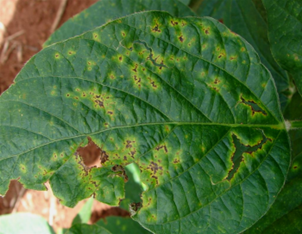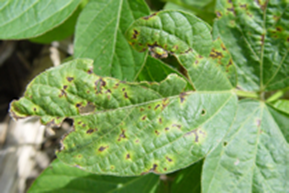The bacterial blight of soybean is caused by the bacterium Pseudomonas syringae pv. Glycinea. The bacteria enter the plant through natural openings and wounds. The disease is most common following windswept thunderstorms or hailstorm. the bacterium survives in infested crop debris and in seed, however, the infested soybean residue is the main source of inoculum. infection usually occurs when the pathogen is carried by splashing or wind-driven rain from infected plant residue to soybean leaves. Symptoms usually begin in the upper canopy because young leaves are most susceptible. It appears as small yellow to brown spots on the leaves. The centres of the spots will turn a dark reddish-brown to black and dry out. A yellowish-green “halo” will appear around the edge of the water-soaked tissue that surrounds the lesions. In advanced infestation levels leaf tattering (tearing) happens when expanding bacterial blight lesions coalesce and form large brown patches.
Leaf symptoms of bacterial blight may be confused with soybean rust and Septoria leaf spot. However, bacterial blight will be in the mid-upper canopy and have green leaves below the affected area while soybean rust and Septoria leaf spot tend to appear lower in the crop canopy.


.png?height=120&name=AgroScout_logo_Big_High_Resolution-(1).png)